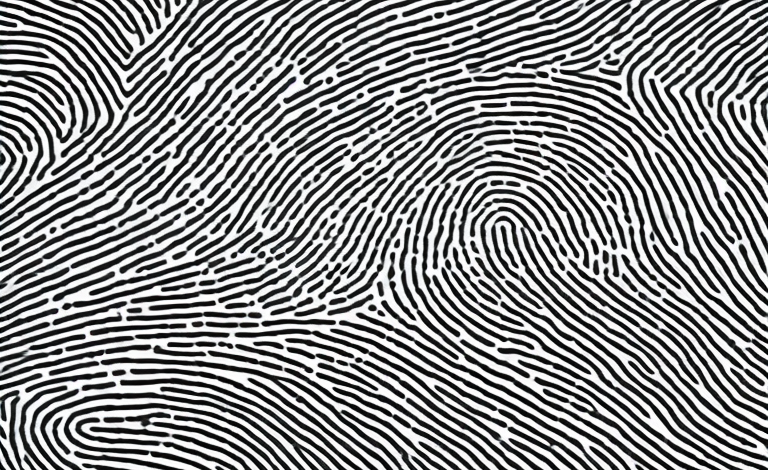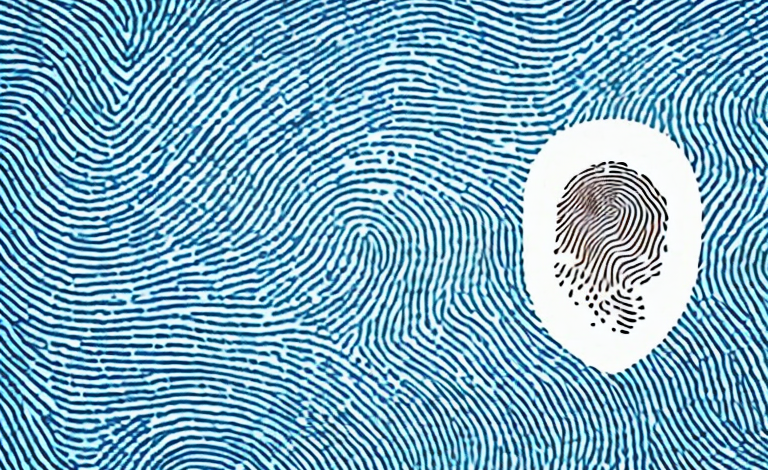Fingerprints are an essential method of identification, especially in forensic science. The average person may assume that their fingerprints are the same on all ten fingers, but is this truly the case? Let’s explore the science behind fingerprint identification.
The science behind fingerprint identification
Fingerprint identification is based on the presence of unique patterns on the skin of our fingertips. The ridges on our fingers are made up of tiny loops, arches, and whorls that give each person an individualized identification that is different from anyone else’s. Forensic scientists can use fingerprints to identify individuals based on these patterns, which remain unchanged throughout a person’s life.
One of the reasons why fingerprints are so useful in forensic investigations is that they are difficult to alter or fake. Even if someone tries to remove their fingerprints, the ridges will eventually grow back in the same pattern. Additionally, fingerprints are not affected by age, gender, or ethnicity, making them a reliable form of identification across different populations.
While fingerprint identification has been used for over a century, advancements in technology have made it even more accurate and efficient. Automated fingerprint identification systems (AFIS) use computer algorithms to match fingerprints against large databases, allowing for faster and more precise identification. In recent years, researchers have also explored the use of other biometric identifiers, such as palm prints and facial recognition, but fingerprints remain one of the most widely used and trusted forms of identification in forensic science.
How do fingerprints form?
Fingerprints begin to form while we are still in the womb, at around 10 weeks of gestation. During fetal development, the skin on our fingers grows faster than the tissue beneath it, causing the skin to wrinkle and fold. As the skin continues to grow, the ridges and valleys form unique patterns that become our individual fingerprints. These patterns are determined by genetics and are unique to each person.
Interestingly, fingerprints are not only unique to humans but also to other primates such as gorillas and chimpanzees. However, the patterns are not as complex as human fingerprints.
Fingerprints are not only used for identification purposes but also have other functions. They help us grip objects better by increasing friction between our fingers and the object. Additionally, they help us sense texture and feel by detecting vibrations and pressure changes on the skin’s surface.
The uniqueness of fingerprints
It is important to note that no two fingerprints are exactly alike. Even identical twins have different fingerprints. This individualization is what makes fingerprints such a valuable tool in identification, especially for forensic purposes. It is also why fingerprints are used in personal identification, like for passports and other important documents.
In addition to their uniqueness, fingerprints also have other distinguishing characteristics that make them useful in identification. For example, the ridges and patterns on a fingerprint are consistent throughout a person’s life, and they do not change even if a person gains or loses weight. Additionally, fingerprints are difficult to alter or disguise, making them a reliable form of identification. These factors, combined with their individualization, make fingerprints an essential tool in law enforcement and personal identification.
The role of fingerprints in forensic investigations
Fingerprints play a significant role in forensic investigations. Investigators may find fingerprints left at crime scenes, which can provide evidence that links a suspect to a crime. However, it is not always easy to collect and analyze fingerprint evidence, as we will discuss later in this article.
One of the reasons why fingerprints are so valuable in forensic investigations is because they are unique to each individual. Even identical twins have different fingerprints. This means that if a fingerprint is found at a crime scene, investigators can use it to identify a suspect with a high degree of certainty. In addition, fingerprints are difficult to alter or disguise, making them a reliable form of evidence.
The history of fingerprinting and its evolution over time
Fingerprinting as a method of identification has been around for thousands of years, with evidence of its use in ancient Babylonian business transactions. The modern method of fingerprint identification was developed in the late 19th century by Sir Francis Galton, a British scientist. Since then, fingerprinting technology has continued to evolve, with new techniques for collecting and analyzing fingerprints continuously being developed.
One of the major advancements in fingerprinting technology was the development of automated fingerprint identification systems (AFIS) in the 1980s. AFIS uses computer algorithms to compare and match fingerprints, making the identification process faster and more accurate. This technology has been widely adopted by law enforcement agencies around the world.
In recent years, there has been a growing interest in using fingerprints for purposes beyond identification, such as medical diagnosis and drug testing. Researchers have found that certain patterns in fingerprints can be indicative of certain medical conditions, such as Parkinson’s disease and diabetes. Additionally, fingerprints can be used to detect drug use, as traces of drugs can be found in sweat and oil on the skin.
Differences between types of fingerprints – loops, arches, and whorls
There are three types of fingerprints: loops, arches, and whorls. Loops are the most common type of fingerprint pattern, accounting for about 60-65% of all fingerprints. Arches make up about 5%, while whorls are present in 30-35% of fingerprints. Loops are characterized by a ridge entering from one side, making a curve and exiting from the same side. Arches are a more rounded pattern with ridges entering on one side and exiting on the other. Whorls have ridges that make a circular or spiral pattern.
Each type of fingerprint pattern has unique characteristics that can be used to identify individuals. Loops can be further classified as radial loops or ulnar loops, depending on which side of the finger the loop opens towards. Arches can be divided into plain arches and tented arches, based on the presence of a spike in the center of the pattern. Whorls can be classified as plain whorls, central pocket whorls, double loop whorls, and accidental whorls, depending on the number and location of the ridges.
Fingerprints have been used for identification purposes for over a century, and their reliability and accuracy have been proven in various criminal investigations. In addition to criminal investigations, fingerprints are also used for background checks, employment screening, and immigration purposes. The study of fingerprints is known as dactyloscopy, and it involves the analysis and comparison of fingerprints to determine their uniqueness and identify individuals.
Can fingerprints change over time?
While fingerprints are unique to each individual and remain unchanged throughout a person’s life, there can be some changes to fingerprints due to injury or aging. Scar tissue, for example, can affect the appearance of a fingerprint, making it more difficult to identify. Aging can also cause changes in skin texture and can create differences in the patterns of fingerprints. However, these changes are typically minor and do not affect the overall uniqueness of the fingerprint.
How is fingerprint evidence collected at a crime scene?
Fingerprint evidence can be collected in a variety of ways, including dusting for fingerprints, using chemical reagents to reveal fingerprints on surfaces, and using adhesive tapes to lift prints off of smooth surfaces. However, it is not always easy to collect reliable fingerprint evidence, as environmental factors like heat, moisture, or touch can distort or destroy the prints, making it difficult to use them in forensic investigations.
Limitations and challenges in using fingerprints for identification
While fingerprints are an invaluable tool in identification, there are limitations and challenges in using them for forensic investigations. As mentioned earlier, environmental factors can impact the integrity of fingerprint evidence. Additionally, some people may have poor-quality fingerprints that cannot be accurately identified, which can present challenges in matching fingerprints to a specific individual.
The future of fingerprinting technology
The use of fingerprinting technology is continuing to evolve, with new techniques and technologies being developed to improve the accuracy and reliability of fingerprint identification. The development of advanced imaging technologies and analysis software will allow for more precise matching of fingerprints, improving the accuracy of forensic investigations and other identification processes.
Famous cases where fingerprints played a crucial role in solving a crime
Fingerprints have been used to solve many high-profile crimes over the years. One of the most famous examples is the case of Brandon Mayfield, a lawyer from Portland, Oregon, who was wrongly accused of involvement in the Madrid train bombings in 2004 based on flawed fingerprint evidence. Another high-profile case involved the Unabomber, who was identified and captured in 1996 due to fingerprint evidence recovered from one of his bombs.
The accuracy and reliability of fingerprint analysis
While fingerprint analysis is generally considered a reliable method of identification, there have been cases where errors have occurred. The Mayfield case mentioned earlier is an example of how inaccurate fingerprint analysis can lead to wrongful accusations. To address these concerns, fingerprint analysis is typically subjected to rigorous scrutiny and validation to ensure the highest level of accuracy and reliability.
The ethics surrounding the use of fingerprints in law enforcement
The use of fingerprints in law enforcement raises ethical concerns related to privacy and civil liberties. The collection and storage of fingerprint data by government agencies for identification purposes can be seen as an infringement on individual privacy. However, fingerprinting is generally considered a necessary tool for law enforcement to maintain public safety and solve crimes.
Fingerprinting as a tool for personal identification
Beyond forensic investigations and law enforcement, fingerprints are used in personal identification as well. Many countries require fingerprints as part of the process for obtaining passports and other important documents. Fingerprinting is also becoming more common in other areas, such as biometric authentication for secure access to devices and systems.
Common misconceptions about fingerprinting
Many people have misconceptions about fingerprints, such as the belief that they can be altered or disguised. Additionally, some people may believe that wearing gloves or other coverings on the hands will prevent fingerprints from being left behind, which is not true. While it is true that gloves can reduce the amount of oil and sweat left behind, they will not prevent fingerprints from being left on surfaces.
Comparing the accuracy of fingerprint versus facial recognition technology
While fingerprinting is a reliable method of identification, facial recognition technology is becoming more prevalent in identification processes as well. Facial recognition has its benefits, including its non-invasive nature and the ability to identify individuals in real-time. However, there are concerns about the accuracy of facial recognition algorithms, especially when it comes to identifying people of color or those with non-traditional facial features.
How to properly care for your fingers to ensure accurate prints
If you want to ensure that your fingerprints are accurately identified in identification processes, there are some steps you can take to care for your fingers. Keeping your hands clean and moisturized can help prevent dryness, which can affect the appearance of fingerprints. Additionally, avoiding cuts and injuries to your fingers can prevent scar tissue from affecting the appearance of your fingerprints.
In conclusion, fingerprints are a unique and valuable tool for identification, both in forensic investigations and personal identification. While there are limitations and challenges in using fingerprint evidence, it remains one of the most reliable methods of identification available to us today.



